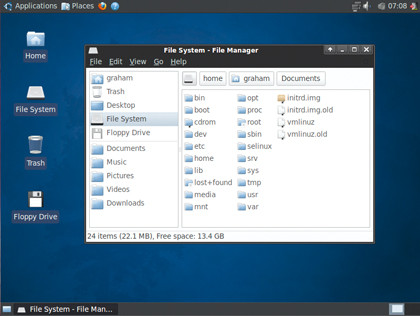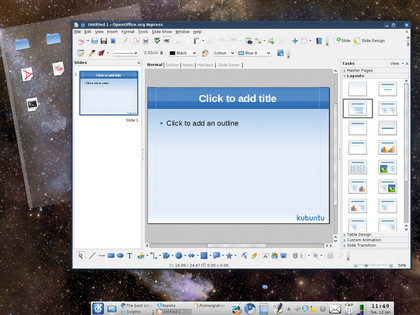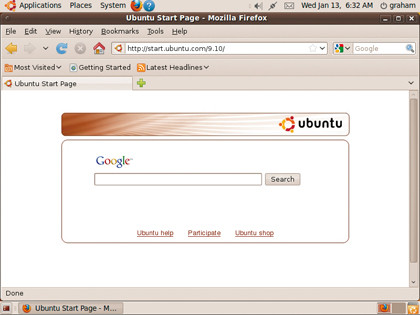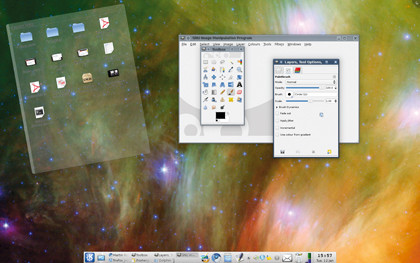Linux desktop innovations to look forward to
2010 is shaping up to be a perfect year for the Linux desktop
Here's what we've got look forward to in the following 12 months
Xfce
There's no doubt that both Gnome and KDE are stealing the limelight when it comes to feature upgrades for 2010. The other more common Linux desktops don't have any such big upgrades planned, and this is their strength, as they often like to capitalise on their ability to remain stable and relatively lightweight.
Xfce is the best example of this: changes from one version to the next are generally small and lack the paradigm shifting-hype of other desktop environments. Xfce 4.8 only entered the planning stage in August last year, and as a result, the feature list is best described as nebulous.

It's hoped that the new version will include an enhanced menu system, icon routines and keyboard handling, but there aren't any ambitious plans to add masses of new features. The new menu system is hopefully going to make it much easier for users to edit the launch menu, a task that currently generates plenty of complaints, according to Xfce developers.
Xfce should also been able to jump on to the on-screen notification bandwagon, with Xfce developer Jérôme Guelfucci showing off patches that bring Gnome's notification system to the Xfce desktop. It looks really good too.
The new file manager, Thunar, is also likely to become more powerful, although one of its great strengths is that it's super quick and not hampered by the cruft that plagues other file managers. The final version of 4.8 is due to be released on 12 April 2010.
Sign up for breaking news, reviews, opinion, top tech deals, and more.
OpenOffice.org
The most comprehensive open source office suite is likely to go through something of a transformation this year, now that its principal sponsor, Sun Microsystems, is being taken over by Oracle. At the time of writing, the first release candidate of version 3.2 has just made it on to the mirrors.
It promises faster startup times, almost halving the boot time for Writer from just over 11 seconds in version 3 to under six seconds in version 3.2, and should bring much better file compatibility with both the new ODF 1.2 specification as well as proprietary formats and the ability to save password-protected Microsoft Office documents.

Version 3.3, which should be available by the end of the year, will be the first release to include the fruit from project Renaissance. This is a noble attempt by OpenOffice.org to overhaul the user interface of the various applications in the suite, hopefully pulling its appearance into the 21st century.
This update is promised only for Impress, with the other applications getting the same treatment in later updates, but until we see a screenshot of the new design, we have yet to be convinced.
Firefox
There's little doubt that the next 12 months are going to be particularly challenging for the Firefox web browser. Once the darling of the open source desktop, Firefox has suffered in the face of competition from Google's Chromium browser and its perceived lack of speed in the face of the growing dominance of WebKit-based browsing.
As a result, future development is likely to focus on speed improvements and consolidating the initial reasons for Firefox's success, rather than adding feature after feature on to a browser than many users feel is already bloated.

But so far, the current roadmap for Firefox couldn't exactly be described as exciting. There are several significant updates planned for Firefox this year, starting with version 3.6, which should be out as you read this. Beta versions of version 3.6 have shown decent JavaScript speed improvements as well as support for 'Personas', which is a theming engine similar to the one used in Google's Chrome.
Version 3.7, available in the middle of the year should make further performance and include the latest version of the Gecko rendering engine.
Jetpack is also worth a mention. It's a way for web developers to build Firefox add-ons using the same skills they use for website construction, including HTML, CSS and JavaScript. But the best thing about Jetpack is that add-ons can be installed without requiring a tedious restart of Firefox.
Finally, there's a small chance that Firefox version 4.0 could be seen on the mirrors before the end of the year. There doesn't seem to be much to get excited about – it's likely to feature the predictable makeover, faster JavaScript and a newer Gecko engine – but it might surprise us.
Gimp
After years languishing in the pool of applications known as 'loved and lost', Gimp looks like it may finely rise from the ashes of apathy and re-invent itself as the future of pixel editing on the free desktop.
Version 2.6, released in October 2009, was a step in the right direction, but it's going to be version 2.8 that hopefully heralds the dawn of a new era. This is mainly because a brand-new, revised and re-imagined GUI is planned, finally consigning its multiple tiny dialogs and windows to the rubbish bin.

Gimp 2.8 will include a single-window mode, just like its commercial competitor, and this should go a long way towards making it easier to use for most people. In the words of one of the main developers on the project, Martin Nordholts, Gimp's UI feels rather cluttered. This is mainly because it uses so many windows, and the single window should solve most of these problems.
But it's a big job. There are nine separate tasks required to make the modification work, with this feature alone taking up about 10% of the projected development time for the next release. Most people agree that it's going to be worth it.
The remainder of the development time is going to be spent adding lots of other cool features. You'll be able to type text directly into the image canvas, for example, rather than using a text entry window first. You will also be able to group layers, making larger and more complex images vastly more manageable.
But development on Gimp has always been dependent on its relatively small and dedicated team. In the past, this has meant there was a long gap between releases, and it's likely to be the same with 2.8. Martin Nordholts initially estimated that if they included all the features they wanted, 2.8 might not see the light of day until early 2012.
He suggested a compromise, pulling ideas like vector layers and unified and free transform tools from the feature plan, and pulling the release forward to before the end of 2010.
Development
There's been a slight shift in recent years from open source project being built purely by the community that uses them, to applications that are developed and sponsored by a commercial endeavour. Google's Chrome browser falls into this category, and so does Nokia's development environment, Qt Creator.
The result is that we've never had a better selection of web browsers, and if you enjoy programming, there are now more Linux-compatible development environments that ever to choose from.
If you're a Qt/C++ developer, Qt Creator is going from strength to strength, and is likely to be the best choice if you're thinking of joining the throngs of developers writing applications for Nokia's various mobile phones.
In a related field, KDevelop 4 is finally due to be released some time in the first half of 2010. This is one of the final KDE 3-era applications to have made the transition to KDE 4, and we hope it will be good enough to last a few years before the developers decide to start from scratch again.
KDevelop 4 uses CMake for project management, and lets you have more than one project open at a time. There's also some sophisticated refactoring, argument matching and support for distributed version control systems such as Git. But KDevelop will no longer enjoy the wide language support of its predecessor, as it become increasingly adept at the C++/Qt combination – a space now defiantly occupied by Qt Creator.
For Gnome developers there are likely to be a couple of releases of the Anjuta IDE, the first of which will be version 2.29.2. MonoDevelop, the multilingual IDE that specialises in C#, is also going from strength to strength, with version 2.2 being released right at the end of the year.
There are currently no plans for version 2.4, but at the current rate of released, we'd expect another version before the end of the year.
-------------------------------------------------------------------------------------------------------
First Published in Linux Format Issue 129
Liked this? Then check out
Sign up for TechRadar's free Weird Week in Tech newsletter
Get the oddest tech stories of the week, plus the most popular news and reviews delivered straight to your inbox. Sign up at http://www.techradar.com/register